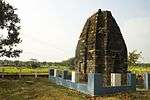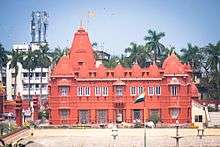Jainism in Bengal
| Part of a series on |
| Jainism |
|---|
 |
|
Jain prayers |
|
Ethics |
|
Major figures |
|
Major sects |
|
Festivals |
|
Pilgrimages |
|
|
Archaeological evidence shows Jainism was a significant religion in Bengal during the early historic period.[1]
Sarak
Saraks are a Jain community in Bihar, Bengal, Orissa and Jharkhand. They have been followers of Jainism since ancient times; however, they were isolated and separated from the main body of the Jain community in western, northern and southern India.
According to Ramesh Chandra Majumder, the Jain scholar Bhadrabahu, the second Louhacharya and the author of Kalpa Sutra may have come from the Sarak community.[2] The Saraks were agriculturists and moneylenders having landed properties.
They have continued to remain vegetarian even though this practice is uncommon among other communities in the region. Saraks have Parshva as a favored patron and recite the Ṇamōkāra mantra. The 24th Tirthankara Mahavira visited this region according to the Kalpa Sūtra.
The Saraks lost contact with Jains in the rest of India after its conquest by Ikhtiyar Uddin Muhammad bin Bakhtiyar Khilji. Contact with the Digambara Bundelkhand Jains was reestablished when the Parwars Manju Chaudhary (1720–1785) was appointed the governor of Cuttack by the Maratha Empire.
In 2009, more than 165 Sarak Jains living in parts of West Bengal, Bihar and Jharkhand visited the ancient Jain pilgrimage center of Shravanabelagola. A special function to welcome the Sarak Jains was organised at Shravanabelagola.[3]
Population
Population by district
Most of the Bengali Jains now live in the Indian state of West Bengal.
| # | District | Total population | Jain population | % |
|---|---|---|---|---|
| 1 | Kolkata | 4,496,694 | 21,178 | 0.47% |
| 2 | Haora | 4,850,029 | 9,699 | 0.20% |
| 3 | North 24 Parganas | 10,009,781 | 4,452 | 0.04% |
| 4 | Puruliya | 2,930,115 | 3,052 | 0.10% |
| 5 | Murshidabad | 7,103,807 | 3,037 | 0.04% |
| 6 | Bankura | 3,596,674 | 2,904 | 0.08% |
| 7 | Hugli | 5,519,145 | 2,160 | 0.04% |
| 8 | Koch Bihar | 2,819,086 | 1,869 | 0.07% |
| 9 | Darjiling | 1,846,823 | 1,840 | 0.10% |
| 10 | Barddhaman | 7,717,563 | 1,674 | 0.02% |
| 11 | Paschim Medinipur | 5,913,457 | 1,550 | 0.03% |
| 12 | Jalpaiguri | 3,872,846 | 1,461 | 0.04% |
| 13 | Uttar Dinajpur | 3,007,134 | 1,324 | 0.04% |
| 14 | Birbhum | 3,502,404 | 1,152 | 0.03% |
| 15 | South 24 Parganas | 8,161,961 | 972 | 0.01% |
| 16 | Maldah | 3,988,845 | 639 | 0.02% |
| 17 | Purba Medinipur | 5,095,875 | 574 | 0.01% |
| 18 | Dakshin Dinajpur | 1,676,276 | 323 | 0.02% |
| 19 | Nadia | 5,167,600 | 281 | 0.01% |
| West Bengal (Total) | 91,276,115 | 60,141 | 0.07% |
Trends
| Census year | % of total population |
|---|---|
| 1951 | 0.08% |
| 1961 | 0.08% |
| 1971 | 0.07% |
| 1981 | 0.07% |
| 1991 | 0.05% |
| 2001 | 0.07% |
| 2011 | 0.06% |
Temples

 Large Statue of Shitalanatha at Pakbirra
Large Statue of Shitalanatha at Pakbirra Jain temple in Pakbirra
Jain temple in Pakbirra Jain idol, Pakbirra
Jain idol, Pakbirra- Shitalanatha Temple, Kolkata
- The Parshwanath Temple, Calcutta
 The Parshwanath Temple, Gouribari
The Parshwanath Temple, Gouribari Shitalnath Bhagwan Temple, Badridas Temple Street, Kolkata
Shitalnath Bhagwan Temple, Badridas Temple Street, Kolkata Chandraprabhu Temple, Badridas Temple Street, Kolkata
Chandraprabhu Temple, Badridas Temple Street, Kolkata
- Dadabari, Badridas Temple Street, Kolkata
See also
| Wikimedia Commons has media related to Jainism in Bengal. |
References
- ↑ Bibliography PC Bagchi, 'Development of Religious Ideas' in RC Majumdar (ed), History of Bengal, Vol-1, Dacca, 1968 (2nd edn);
- ↑ Kundu, Santosh Kumar (2008). Bangali Hindu Jati Parichay [An Introduction of Bengali Hindu Castes] (in Bengali). Kolkata: Presidency Library. pp. 273–275. ISBN 978-81-89466-13-8.
- ↑ "> News Updates". Www.Jainheritagecentres.Com. 2009-09-02. Retrieved 2012-05-19.
- ↑ Population by religious community: West Bengal. 2011 Census of India.
- ↑ B.P. Syam Roy (28 September 2015). "Bengal's topsy-turvy population growth". The Statesman.